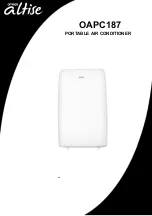
ENGLISH-23
02
INST
ALL
ATION
Insulation
Once you have checked that there are no leaks in the system, you can insulate the piping and hose .
1 .
To avoid condensation problems, place an insulator around each
refrigerant pipe.
• When insulate the pipe, be sure to overlap the insulation .
NOTE
• When insulating the pipe, use non-slit insulator .
CAUTION
NBR
2 .
Select the insulation of the refrigerant pipe.
X
f
Insulate the gas side and liquid side pipe referring to the thickness according to the pipe size.
X
f
Less than Indoor temperature of 30 °C and humidity of 85 % is the standard condition . If installing in a high humidity
condition, use one grade thicker insulator by referring to the table below . If installing in an unfavorable conditions, use
thicker one .
X
f
Insulator’s heat-resistance temperature should be more than 120 °C .
Pipe
Pipe size
Insulation Type (Heating/Cooling)
Remarks
Standard [Less than 30 °C, 85 %]
High humidity [over 30 °C, 85 %]
EPDM, NBR
Liquid pipe
Ø6 .35~Ø9 .52
9 t
9 t
Internal temperature is
higher than 120 °C
Ø12 .7~Ø19 .05
13 t
13 t
Gas pipe
Ø6 .35
13 t
19 t
Ø9 .52~Ø19 .05
19 t
25 t
X
f
When installing insulation in places and conditions below, use the same insulation that is used for high humidity
conditions .
<Geological condition>
- High humidity places such as shoreline, hot spring, near lake or river, and ridge (when the part of the building is
covered by earth and sand .)
<Operation purpose condition>
- Restaurant ceiling, sauna, swimming pool etc .
<Building construction condition>
- The ceiling frequently exposed to moisture and cooling is not covered .
e .g . The pipe installed at a corridor of a dormitory and studio or near an exit that opens and closes frequently .
- The place where the pipe is installed is highly humid due to the lack of ventilation system .
CAC_Global Duct Latin America_IM_EN_04680A-02.indd 23
2014-09-04 오전 9:17:30









































